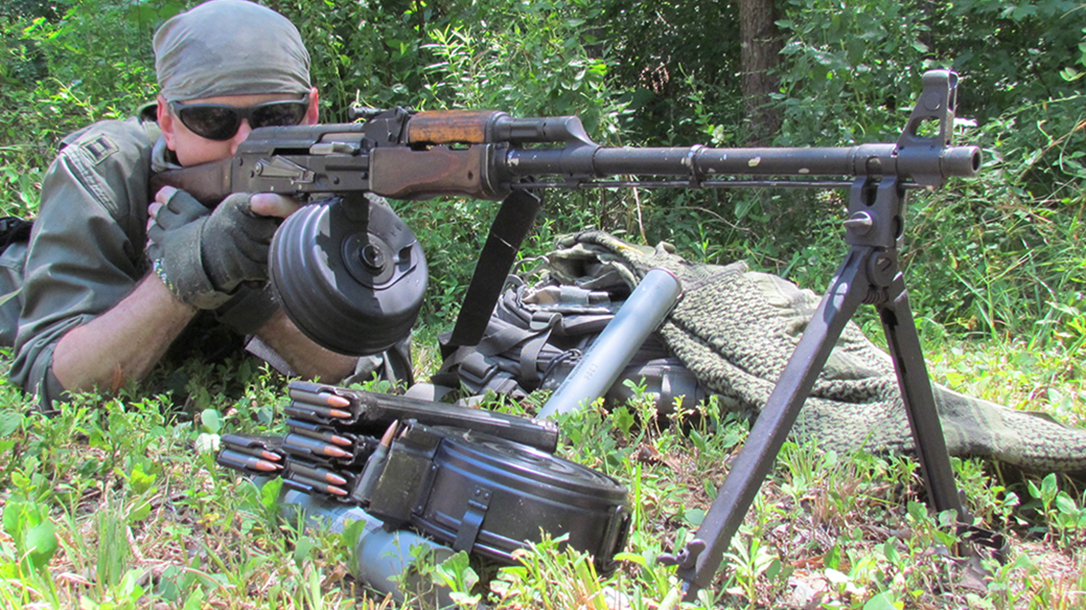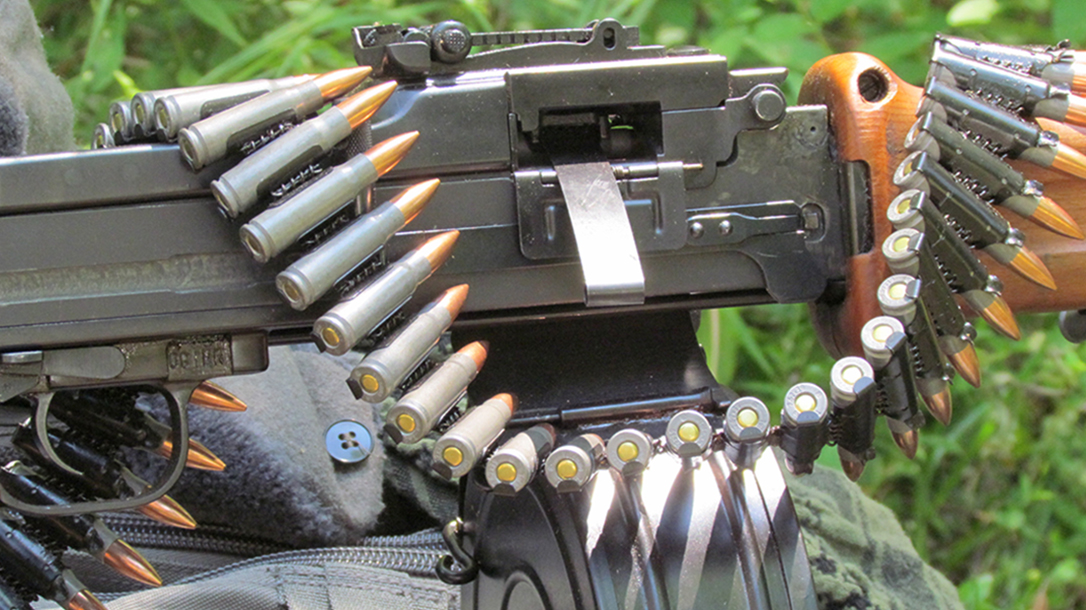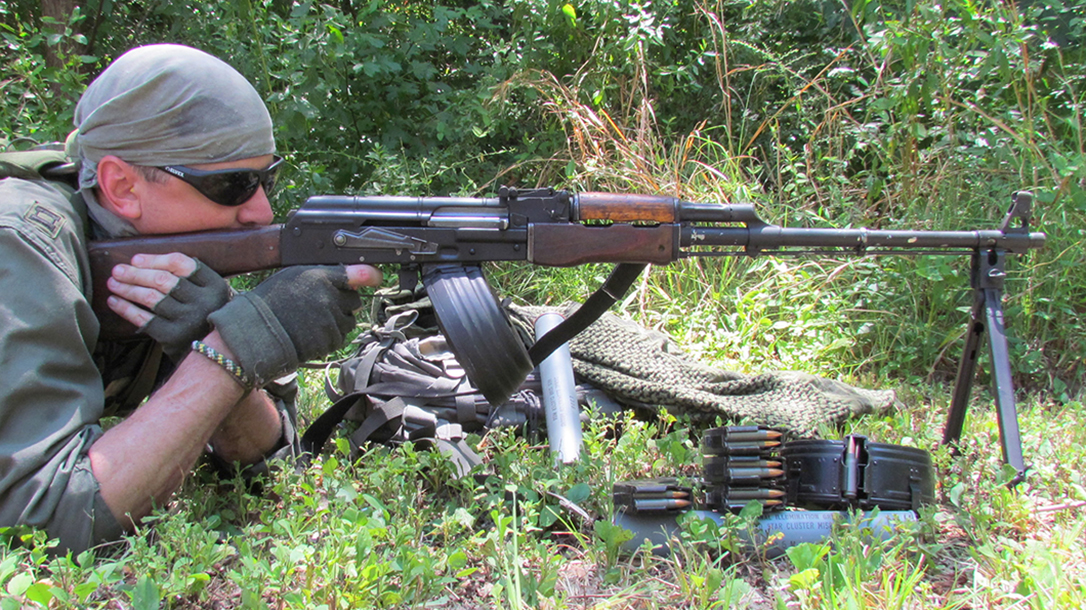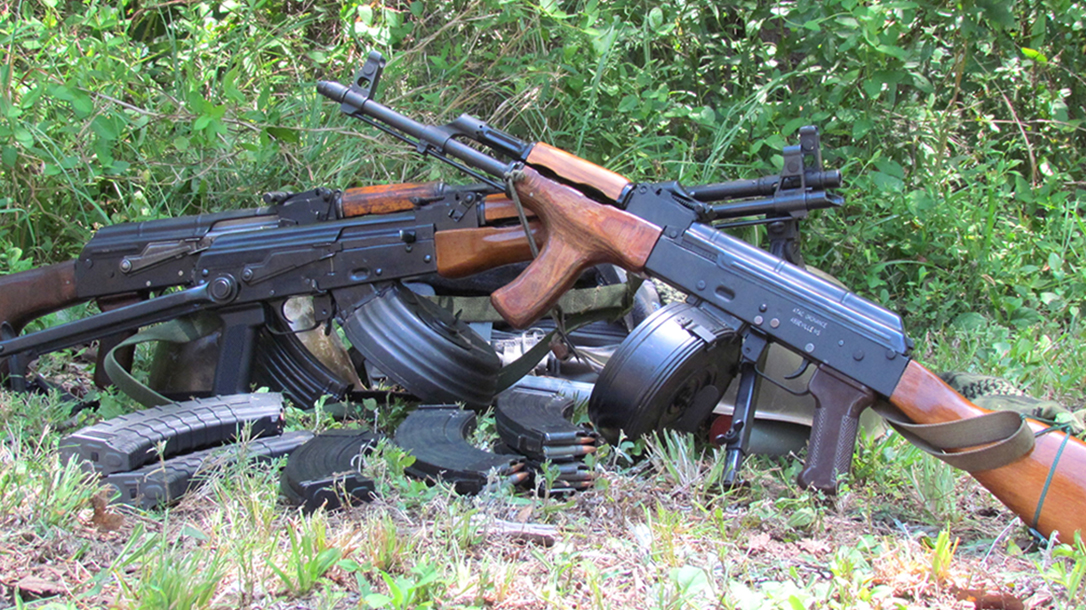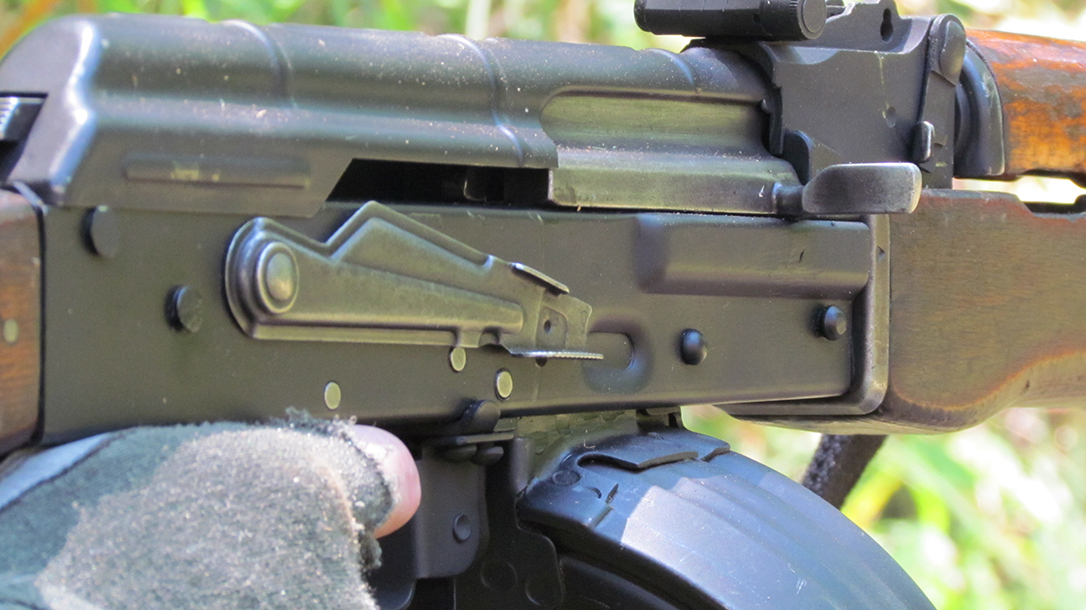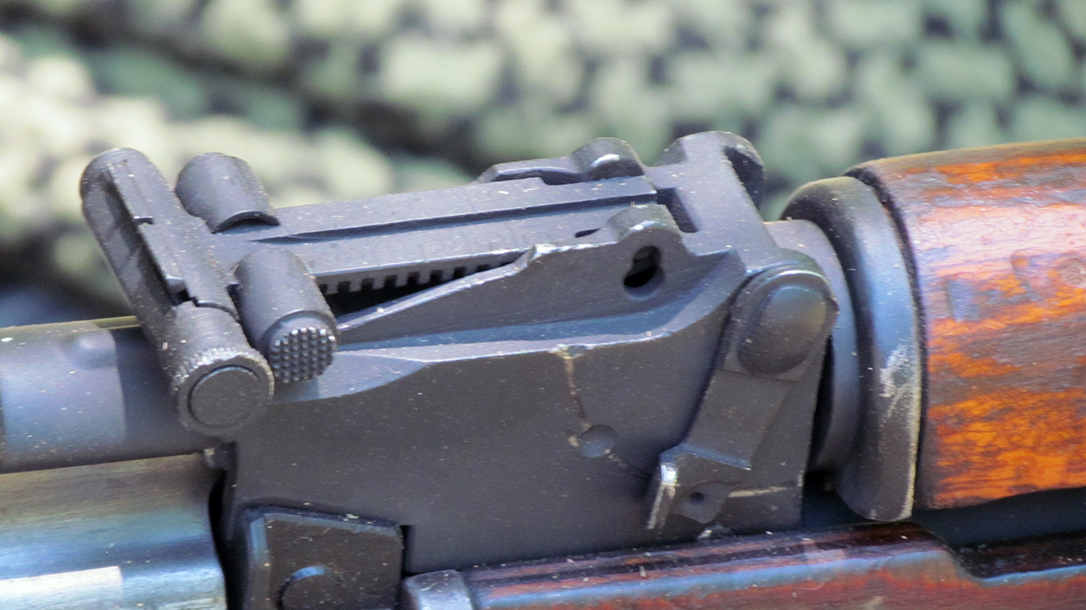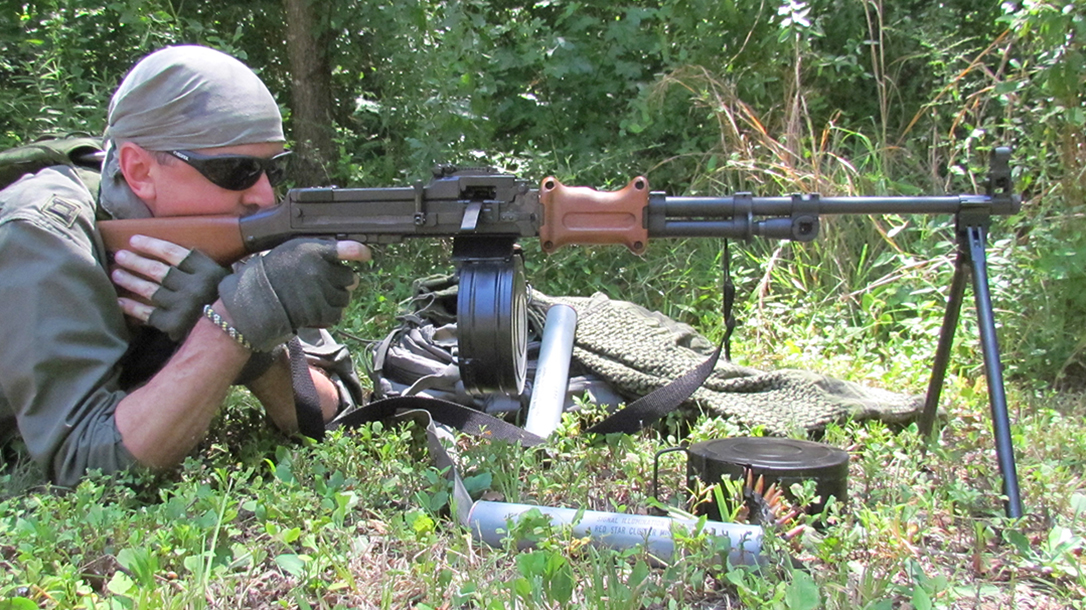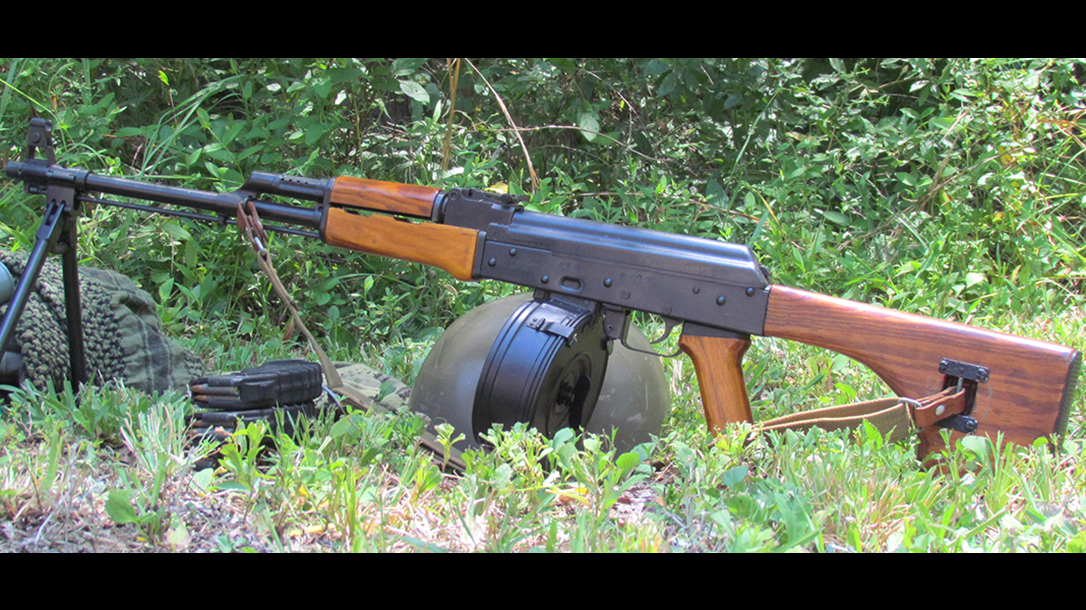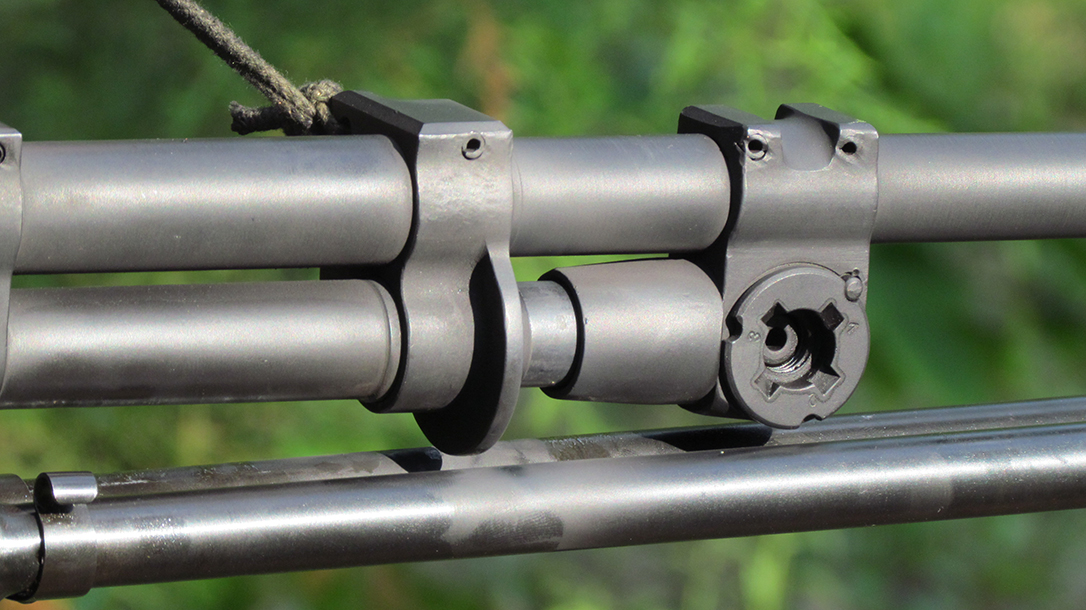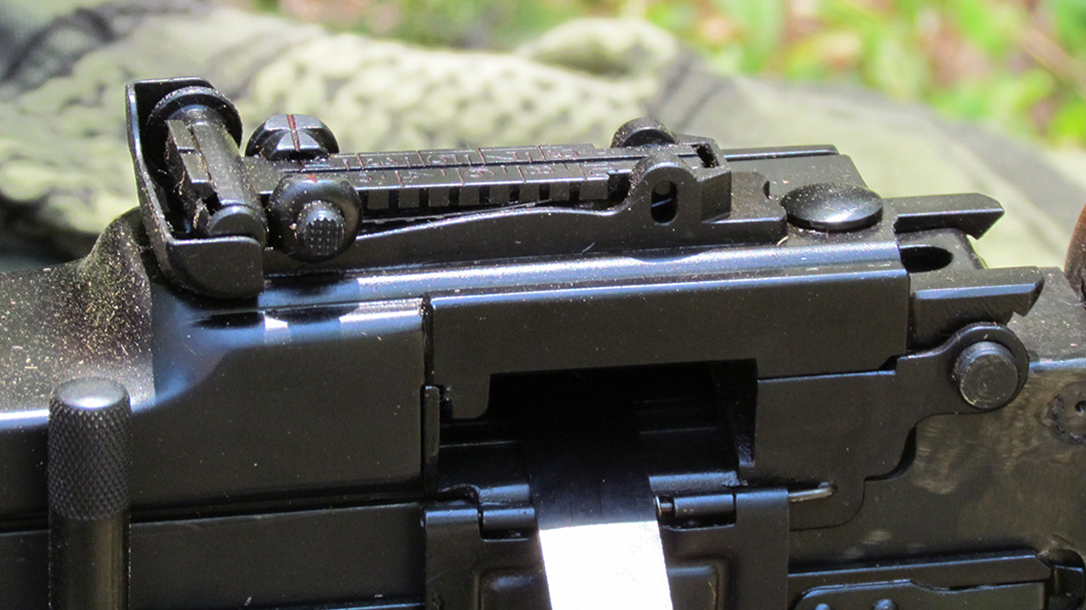Cold War Communists, despite their misguided ideology, were dedicated and enthusiastic. The devastating legacy of World War II was burned into their collective psyche in a way that Americans could never imagine. As a result, Communist countries built weapons and armies as though their lives and families depended on them. Although not quite as technologically elegant as their Western counterparts, the Communist products were robustly executed and exquisitely well engineered. In few ways is this concept better exemplified than in Communist Bloc squad automatic weapons, or SAWs.
In 1943, work began on the Ruchnoy Pulemyot Degtyaryova (RPD) light machine gun, a belt-fed 7.62x39mm adaptation of the basic action used in the pan-fed DP machine gun of WWII. The RPD was a magnificent weapon for its time. It’s fed from a pair of non-disintegrating 50-round belts that link together to provide 100 rounds of onboard firepower carried in a round sheet-steel drum. Especially when compared to the Browning Automatic Rifle, the M14A1 and the M60, the RPD is lightweight and deadly. The design has been criticized for not incorporating a quick-change barrel, but many commentators might be blurring the lines between an SAW and a general-purpose machine gun. Remember, the RPD was intended to provide a mobile base of fire during an assault, not necessarily to hose down the countryside from a fixed position for long periods.
Advertisement — Continue Reading Below
The RPD’s replacement was the Ruchnoy Pulemyot Kalashnikova (RPK). Adopted in the early 1960s, the RPK is basically an AKM on steroids. Weighing a little over 10 pounds unloaded, the RPK uses the same bolt and bolt carrier as the AKM but incorporates a more robust receiver, a longer, heavier barrel, and a clubfoot buttstock and bipod that allow for a more stable firing platform than that of the standard AKM. The RPK can be fed from standard 30-round AK magazines, extended 40-round magazines or 75-round drums. The RPK also lacks a quick-change barrel.
Esoterically at least, the RPK has always seemed like a step backward to me. Being magazine fed, it lacks the theoretically limitless ammunition supply of its belt-fed predecessor, and its lighter weight—although a boon to the unfortunate soldier who has to hump the thing long distances—inevitably contributes to burst dispersion. As such, when I found myself with both weapons, I resolved to ruck up and spend a couple of days rolling in the dirt with them just to see if I could follow the thought processes of the long-dead Communist engineers who designed the guns.
The RPD
The RPD’s action is elegant, resulting in a compact, streamlined weapon. The bolt locks in place via a pair of steel flaps that are cammed outward to engage recesses milled into the inside of the receiver. The gas system incorporates three positions for differing ammunition types and degrees of fouling, but adjustment requires a special tool and is a bit tedious. Additionally, the top cover release is a smooth steel sleeve at the back of the top cover assembly that is difficult to manipulate with bare hands and impossible with gloves. So long as the gun is operating smoothly, this is not a problem.
Advertisement — Continue Reading Below
Every other belt incorporates a starter tab so the gun can be loaded without lifting the feed-tray cover. To load the gun, you retract the bolt back to its stop and feed the starter tab through from left to right until the first round locks in place. As the gun fires from the open bolt, pressure on the trigger releases the bolt assembly and the gun runs. However, clearing stoppages on a dirty gun while in a hurry can be frustrating.
RPD Details
Changing drums involves throwing a latch at the back of the drum, sliding the empty off its dovetail to the rear, attaching a fresh drum in the same manner and then securing the latch. You then open a spring-loaded door in the top of the drum, secure the belt via the starter tab, and feed the ammunition into the action as described. After the first 50 rounds, the spent belt falls free and the next belt feeds automatically.
The RPD’s safety is a large, positive lever just ahead of the trigger that pivots through 180 degrees. The weapon fires in full-auto only. The front sight is adjustable for windage and elevation in the manner of the AKM, and the rear sight, affixed to the top cover, is adjustable out to 1,000 meters.
Advertisement — Continue Reading Below
The RPK
By contrast, the RPK enjoys a manual of arms that’s essentially the same as that of any of the 100 million or so Kalashnikov rifles in service worldwide. The weapon uses the same clunky ranch-gate safety selector as the AK, and magazines must be pivoted forward and then rocked back to seat in the magazine well.
As with any mil-spec AK, the safety’s top position is “safe,” the middle position is full-auto and the bottom position is semi-auto. The sights function identically to those of the AK and are optimistically adjustable out to 1,000 meters. The RPK also incorporates a micrometer feature in the rear sight assembly, allowing for precise adjustments of windage. The bipod legs are typically adjustable for command height. Aside from the buttstock and bipod, on the user level, the RPK is just a big Kalashnikov. Even a child could use it.
How They Stack Up
In the field, the differences between the weapons become more apparent. Humping the RPD long distances is more arduous than doing so with the RPK based upon its greater weight, but it’s still a marked improvement over an M60, M240 or PKM. The RPD and RPK project a similar profile when fired from prone so long as the RPD’s drum is attached. With both guns, it can be difficult to engage targets on an upward slope because of the bulky ammunition-feed devices projecting beneath the guns. In their assault configurations, maneuvering from the prone position is about the same.
Advertisement — Continue Reading Below
Both guns get hot quickly. The RPD enjoys a modest advantage because of its open-bolt system of operation, but you must use care with both systems when firing bursts for prolonged periods. For either weapon, running even one drum is sufficient to make the handguard uncomfortably warm and the barrels downright scorching.
Although the 100-round capacity of the RPD is a benefit, this is more than offset by belt or drum changes. When I’m moving with purpose, reloading the RPD takes me roughly three times as long as the RPK. Take into account rain, mud or snow and the RPK really starts to pull ahead.
Advertisement — Continue Reading Below
More Considerations
It’s a more natural exercise to fire protracted bursts from the RPD than from the RPK, as the added mechanical bulk stabilizes the RPD. However, because its mission is to provide squad-level fire support during maneuvers, the RPK is more agile and portable. The RPK reloads significantly more quickly on the move, fires more naturally from the shoulder and is easier to maneuver indoors. Additionally, the RPK can be fed directly from the ammunition magazines used by individual squad members, which is a big plus.
The RPD’s rate of fire is noticeably faster than that of the RPK, which is sedate and more than adequate to allow singles and doubles from an experienced trigger finger. By contrast, the RPD produces bursts comparable to those of Germany’s WWII-era MG 34. It’s not a challenge to burn through a 100-round drum in a hurry. Given the weight of the .30-caliber ammunition they fire, both guns would be tough to keep fed during a protracted mobile engagement.
Final Thoughts
The U.S. Marines have made a great deal of the fact that the M249 SAW fires from an open bolt, which might make it insufficiently reliable for initiating assaults in close-quarters battle (CQB) environments. That was one of the driving forces behind the Marines’ new M27 Infantry Automatic Rifle (IAR) project. Apparently, 1960s-era Communists came to a similar conclusion. In the final analysis, after humping both guns through the woods, maneuvering them indoors and burning through a zillion or so rounds in the dirt, I appreciate their wisdom. The RPK is indeed the better SAW.
Advertisement — Continue Reading Below
RPD vs. RPK
| RPD | RPK | |
|---|---|---|
| Caliber | 7.62x39mm | 7.62x39mm |
| Barrel | 20.5 inches | 23.2 inches |
| OA Length | 40.8 inches | 40.9 inches |
| Weight | 16.31 pounds (empty) | 10.6 pounds (empty) |
| Stock | Wood | Wood |
| Sights | Adjustable | Adjustable |
| Action | Open bolt | Closed bolt |
| Feeding | Belt | Drum or magazine |
| Rate of Fire | 650-750 rpm | 600 rpm |
This article was originally published in the 2018 issue of “AK-47 & Soviet Weapons.” To order a copy, visit outdoorgroupstore.com.
